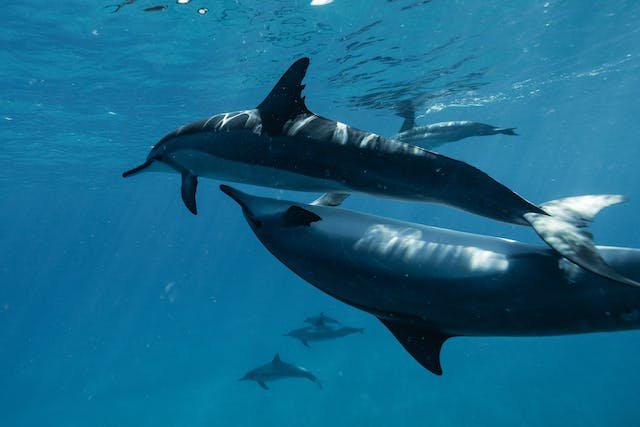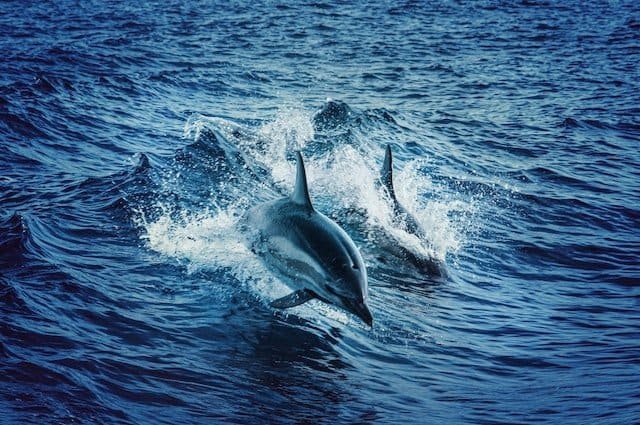Have you ever wondered How Fast Can A Dolphin Swim? The maximum speed at which a dolphin can swim is 60 kilometers per hour (37 miles per hour). Of course, it makes them one of the fastest marine mammals. This astonishing speed is known for Common Dolphins, which are also known as Short-beaked Dolphins.
Table of Contents
Factors contributing to Dolphin speed:
Dolphins are renowned as among the quickest and most agile marine mammals due to their exceptional swimming abilities.
- Body shape and efficient swimming technique: Their long, slender body shape and efficient swimming technique; are the factors that contribute to fast swimming. The dolphin’s body is streamlined to increase its efficiency at resisting the drag associated with swimming through water. The dolphin’s sleek body design decreases resistance as it swims through the water.
- Hydrodynamic body design: Their hydrodynamic body design lets them swim quickly and efficiently by reducing resistance and increasing forward momentum. The study of fluid motion is called hydrodynamics. A dolphin’s forward momentum is generated by the water currents it generates as it swims.
- Skin: The dolphin’s skin is also very smooth, which allows it to move through the water with minimal resistance.
- Bubble curtains: The role of bubbles and bubble curtains in dolphin speed is very significant. When dolphins swim, they produce a coating of bubbles around their body, which decreases resistance and boosts their speed. The air bubbles act as a cushion for the dolphin’s body, reducing drag and facilitating its swimming. A bubble curtain is another name for this bubble layer.
- Propoising or Breaching: ‘Porpoising’ is the term given to the dolphins’ habit of leaping out of the water in pursuit of increased speed. When dolphins ‘porpoise,’ it may look like they’re just showing off, but they’re actually conserving energy by getting out of the water and into the air, where there is less resistance. Multiple functions, such as communication, play, and hunting, are ascribed to this action.

How Fast Can A Dolphin Swim? The Swimming Mechanism of Dolphins:
The dolphin’s powerful tail flukes, dorsal fin, and flippers all work together to propel it through the water. Dolphins use the flukes on their tails to create propulsion and propel themselves ahead when swimming at fast speeds. Like the wings of a bird, a dolphin’s flukes move up and down in a sweeping motion to generate thrust.
Dolphins are able to turn and maneuver in the water with the help of their dorsal fin and flippers in addition to their tail flukes. When swimming, the dolphin uses its dorsal fin as a rudder to assist it to turn and stay stable. The dolphin’s flippers serve as both steering and braking devices, allowing it to rapidly slow down or alter course.
How fast can a common Dolphin swim?

A well-known dolphin species is the common dolphin, also called the short-beaked dolphin. Common dolphins may reach speeds of up to 60 kilometers per hour (37 miles per hour).
How fast can a bottlenose Dolphin swim?
Bottlenose dolphins may reach speeds of up to 32 kilometers per hour (20 miles per hour). One of the most well-known and extensively researched dolphin species is the bottlenose dolphin.
Their sleek bodies and strong tail muscles allow them to travel at speeds that surpass those of most other dolphin species.
Even the quickest swimmers require oxygen, so they surface every minute or so to take a few deep breaths. They’re not just fast; a bottlenose dolphin may swim up to 100 miles in a single day. You can witness dolphins swimming near the coast, breaching (jumping completely out of the water), and lobtailing (slapping their tails on top of the water)—so they’re not bad at acrobatics, either. They’ve been seen to perform spectacular high-flying flips out of the water.
Fun facts about Bottlenose Dolphin:

- Body language: A bottlenose dolphin’s body language includes butting heads, slapping its tail on the water’s surface, blowing bubbles, and leaping as high as 20 feet in the air.
- Whistle: Each newborn dolphin develops its own unique whistle. Like a human name, this whistle is used for recognition.
- Echolocation: High-frequency clicks produced by dolphins serve as a sonar system, a process known as echolocation (ek-oh-low-KAY-shun). The dolphin hears echoes of the clicking sounds when they strike an underwater object like a fish or rock. The dolphins use echolocation to determine the object’s size, velocity, distance, and precise location.
- Social and playful: Bottlenose dolphins are very gregarious and playful mammals that create lifelong bonds via shared activities including hunting, mating, and defending. They enjoy swimming around bubble rings that they have created for themselves and surfing in the wakes of passing vessels.
- Hearing: The hearing of bottlenose dolphins is exceptionally keen. Researchers think the noises enter the dolphin’s inner ear through its lower jaw and are subsequently sent to the brain for processing.
- Shedding of skin: Every two hours, they lose their protective skin.
- Making of mud ring to trap fish: These marine mammals eat fish, squid, and shrimp, among other foods. Dolphins will work together to construct a mud ring to catch fish. The dolphins will then have a snack of the fish that try to escape and will wait outside the ring to eat them.
- What compels dolphins to play chase alongside ship sterns? If two dolphins are headed in the same direction, they can “hitch a ride” by using the energy-saving bow wave to speed up their journey. It’s possible they’re just doing it for kicks, though.
How can we measure Dolphin speed?

Experiments, observations, and recordings are all used to determine dolphins’ top speeds. Researchers employ a variety of cutting-edge technology, such as lasers, GPS, and more, to determine dolphins’ top speeds.
The average speed of Dolphins is 25 miles per hour (about 11 meters per second).
It’s worth noting, too, that this speed could shift based on the dolphin’s age, gender, and other characteristics. Scientists employ a variety of techniques to determine how fast dolphins can swim. A speedometer can be attached to the dolphin’s body to get an accurate reading. Alternatively, a global positioning system might be used to monitor the dolphin’s whereabouts.
Scientists monitor the dolphins’ behavior with underwater cameras and then analyze the footage to calculate their speed. Researchers also undertake experiments to quantify dolphin speed. Researchers trained dolphins to complete a series of timed obstacle courses in the water.
Researchers measured how long it took dolphins to swim through the hoops and used that information to determine the animals’ top speeds. Dolphins’ speeds have been measured with lasers and other cutting-edge technologies in recent years. By projecting a grid of light with lasers, researchers can follow the dolphin’s every motion. This method is both non-invasive and accurate for measuring the speed of dolphins.
Summary:
Their streamlined bodies, strong tails, and smooth skin make these aquatic creatures well-suited for rapid movement. Hunting, avoiding predators, and interacting socially are just a few examples of how important their speed is to their survival. Dolphins use hydrodynamics to decrease their resistance in the water and swim quickly. Their incredible velocity is proof that they have successfully evolved and adapted to the ever-changing conditions of the ocean.
Read Also: What is a baby dolphin called?





